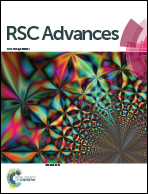CNT–G–TiO2 layer as a bridge linking TiO2 nanotube arrays and substrates for efficient dye-sensitized solar cells
Abstract
This study incorporated a 3-D hybrid material comprising graphene and carbon nanotubes (CNTs) into a TiO2 composite paste to adhere TiO2 nanotube arrays (NTAs) as photoanodes. The effect of the proportion of CNTs to graphene on the dye-adsorption ability of bonding layers was investigated and the optimal proportion of 2 : 1 provided a greatest degree of dye absorption. The DSSC efficiencies firstly increased and then decreased with increasing amount of CNT–G hybrid. The optimized DSSC efficiency of 6.17% was achieved at a suitable concentration (0.1 wt%) of CNT–G, which is due to a balance between electron transport and light harvesting in the photoanode.


 Please wait while we load your content...
Please wait while we load your content...